(Press-News.org) Scientists have discovered how honeybees can decipher dances by their hive mates that relay directions to food.
The findings reveal how, in the complete darkness of the hive, each bee uses its antennae to help interpret the information communicated through the dances.
It has been known for decades that honeybees do so-called waggle dances, in which their movements and orientation on the honeycomb signal the direction and distance to food outside the hive. However, until now, it was unclear how the bees gathered around a waggle dancer make sense of the information.
Gaining greater insights into how bees communicate could help scientists to better understand the effects of issues such as habitat loss and pesticide use on the insects’ ability to find food, researchers say.
A team from the University of Edinburgh made the discovery by studying a colony of honeybees at an apiary at the University and using computational models to mimic their brain processes.
Researchers from the University’s School of Informatics filmed the insects in slow motion and high resolution under infrared light. This enabled them to track the position of the antennae of the surrounding bees in fine detail during each waggle dance – which are otherwise a blur to the naked human eye.
The researchers observed that bees alter the position of their antennae, which are touched repeatedly by the dancer as it waggles by, based on the angle of their body relative to the dancer.
The team realised that the bees could decode dances from any angle, or even from constantly changing positions, by combining signals picked up by their antennae with their own sense of gravity. However, this requires the bee to accurately add together the two angles detected from its two sensory systems.
Using a computer model that replicates known brain circuits in the bee, the researchers showed that fewer than one hundred neurons are needed to integrate this information and recover the angle and the distance to the food being signalled in a waggle dance.
The findings are published in the journal Current Biology. The study was supported by the European Research Council, the Janet Foreman Fund and the Eva Crane Trust.
PhD student Anna Hadjitofi, of the University of Edinburgh’s School of Informatics, said: “This is particularly exciting because it unveils a remarkably elegant neural mechanism employed by bees to decipher complex information with minimal resources”.
Professor Barbara Webb, also of the University’s School of Informatics, added: "Understanding how the small brains of insects carry out such sophisticated calculations can help us design more compact and energy efficient computers”.
For further information, please contact: Corin Campbell, Press and PR Office, +44 (0)7881 004402, corin.campbell@ed.ac.uk
END
Bees use antennae to decode hive mates’ dances in the dark
2024-03-25
ELSE PRESS RELEASES FROM THIS DATE:
Nucleus Genomics launches to bring whole-genome sequencing to the public
2024-03-25
Nucleus Genomics, the next-generation genetic testing and analysis company, today announced the launch of its DNA analysis product to bring the benefits of personalized medicine to everyone.
DNA and health are inextricably linked, but profound insights into how DNA can shape health are missing from healthcare. Customers who’ve previously done microarray genetic testing with older testing companies can upload their DNA data onto Nucleus’ platform to receive greater insights into their genetic risk for diseases like type 2 diabetes, breast cancer, and many more. Nucleus further personalizes these risk assessments by integrating personal ...
How many fish constitute a school?
2024-03-25
Physicists are also interested in fish – above all when they are researching the formation of structures. A research team from Heinrich Heine University Düsseldorf (HHU) and the University of Bristol (United Kingdom) has examined the schooling behaviour of zebra danio (Danio rerio, also known as “zebrafish”) using methods from the field of multi-particle physics. In the scientific journal Nature Communications, they explain that groups of just three fish already move in a similar way to large schools while, by contrast, two fish display completely ...
Provision of medications for self-managed abortion before and after the Dobbs v Jackson Women’s Health Organization decision
2024-03-25
About The Study: Provision of medications for self-managed abortions increased in the six months following the Dobbs v Jackson Women’s Health Organization decision. Results suggest that a substantial number of abortion seekers accessed services despite the implementation of state-level bans and restrictions.
Authors: Abigail R. A. Aiken, Ph.D., of the University of Texas at Austin, is the corresponding author.
To access the embargoed study: Visit our For The Media website at this link https://media.jamanetwork.com/
(doi:10.1001/jama.2024.4266)
Editor’s Note: Please see the article for additional information, ...
Common household chemicals pose new threat to brain health
2024-03-25
CLEVELAND—A team of researchers from the Case Western Reserve University School of Medicine has provided fresh insight into the dangers some common household chemicals pose to brain health. They suggest that chemicals found in a wide range of items, from furniture to hair products, may be linked to neurological diseases like multiple sclerosis and autism spectrum disorders.
Neurological problems impact millions of people, but only a fraction of cases can be attributed to genetics alone, indicating that unknown environmental factors are important contributors to neurological disease.
The new study ...
Unlocking quantum computing power: automated protocol design for quantum advantage
2024-03-25
Imagine a world where complex calculations that currently take months for our best supercomputers to crack could be performed in a matter of minutes. Quantum computing is revolutionizing our digital world. In a research article published Feb. 19 in Intelligent Computing, researchers unveiled an automated protocol-design approach that could unlock the computational power of quantum devices sooner than we imagined.
Quantum computational advantage represents a critical milestone in the development of quantum technologies. It signifies the ability of quantum computers to outperform classical supercomputers in certain tasks. Achieving ...
Pitt receives NIH grants to study health effects of chemical exposures following the East Palestine train derailment
2024-03-25
PITTSBURGH – The University of Pittsburgh has received a pair of two-year grants from the National Institutes of Health to support studies on the health effects of environmental contamination resulting from the train derailment that spilled hazardous materials into the local communities in East Palestine, Ohio, in February 2023.
The grants, totaling nearly $1 million, were awarded through a National Institute of Environmental Health Sciences ...
Researchers Discover Evolutionary “Tipping Point” in Fungi
2024-03-25
Scientists have found a “tipping point” in the evolution of fungi that throttles their growth and sculpts their shapes. The findings, published in the journal Cell Reports, demonstrate how small changes in environmental factors can lead to huge changes in evolutionary outcomes.
Fungi are nature’s great composters. They wait within the forest floor to feed on fallen trees and autumn leaves, releasing essential nutrients from these plants back into the Earth.
Although fungi often ...
Differences in donor heart acceptance by race and gender of patients on the transplant waiting list
2024-03-25
About The Study: The cumulative incidence of heart offer acceptance by a transplant center team was consistently lower for Black candidates than for white candidates of the same gender and higher for women than for men in this study. These disparities persisted after adjusting for candidate-, donor-, and offer-level variables, possibly suggesting racial and gender bias in the decision-making process. Further investigation of site-level decision-making may reveal strategies for equitable donor heart acceptance.
Authors: Khadijah Breathett, M.D., M.S., of Indiana University in Indianapolis, ...
Job flexibility, job security, and mental health among working adults
2024-03-25
About The Study: In this study of 18,000 adults who were employed, greater job flexibility was significantly associated with reduced odds of experiencing serious psychological distress and experiencing anxiety. Greater job security was significantly associated with reduced odds of experiencing serious psychological distress and experiencing anxiety.
Authors: Monica L. Wang, Sc.D., M.S., of the Boston University School of Public Health, is the corresponding author.
To access ...
Inappropriate diagnosis of pneumonia among hospitalized adults
2024-03-25
About The Study: Inappropriate diagnosis of community-acquired pneumonia was common, particularly among older adults, those with dementia, and those presenting with altered mental status in this study of 17,000 hospitalized adults treated for pneumonia in 48 Michigan hospitals. Full-course antibiotic treatment of those inappropriately diagnosed with community-acquired pneumonia may be harmful.
Authors: Ashwin B. Gupta, M.D., of the VA Ann Arbor Healthcare System in Ann Arbor, Michigan, is the corresponding author.
To access the embargoed study: Visit our For The Media website ...






